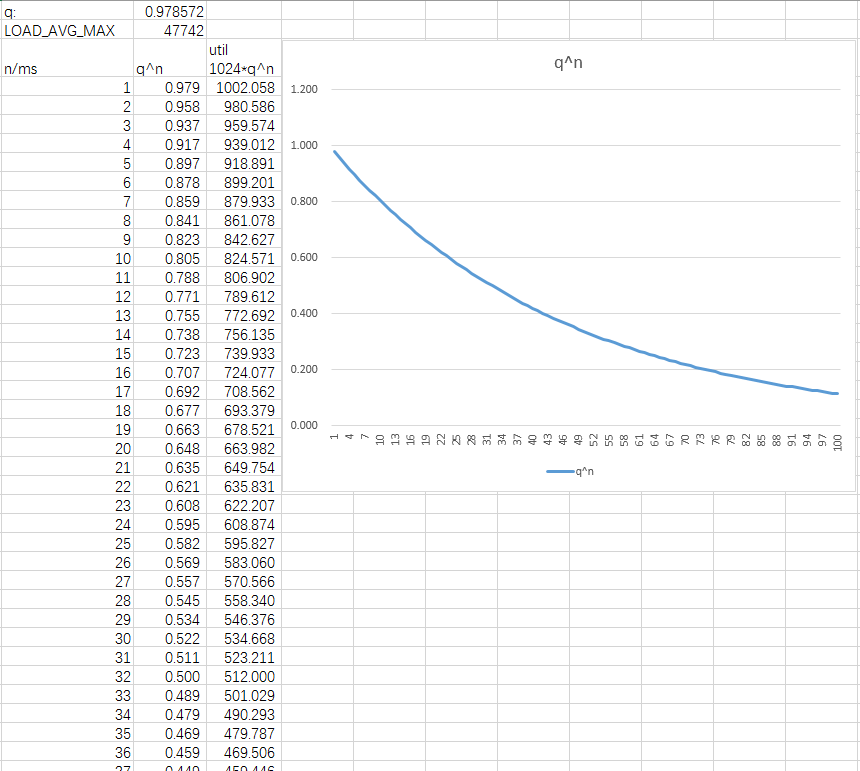这个程序用于 debug 若一个任务突然一直跑下去,其 util_avg 增加的速度。util_avg 是对一个正在运行的任务计算的,若其不允许了,对系统的 util 的影响应该是0,若是 n 个 periods(周期1024us) 后又开始运行了,其 uitl_avg 直接乘以 y^n 即可。
一、测试增速
1. 测试程序
#include <stdio.h> #include <math.h> #include <stdlib.h> #define HALFLIFE_32 32 #define LOAD_AVG_MAX_32 47742 #define HALFLIFE_8 8 #define LOAD_AVG_MAX_8 12326 #define HALFLIFE_4 4 #define LOAD_AVG_MAX_4 6430 #define HALFLIFE_3 3 #define LOAD_AVG_MAX_3 4959 #define HALFLIFE_2 2 #define LOAD_AVG_MAX_2 3493 void calc_converged_max(double y) { int n = -1; /* first period */ long max = 1024; long last = 0, y_inv = ((1UL << 32) - 1) * y; for (; ; n++) { if (n > -1) { max = ((max * y_inv) >> 32) + 1024; /* This is the same as: max = max*y + 1024; */ } if (last == max) break; last = max; } n--; printf("#define LOAD_AVG_MAX %ld ", max); printf("#define LOAD_AVG_MAX_N %d ", n); } int util_avg_from_sudden_running_all_time(double y, int periods, int load_avg_max) { int i; double util_avg; double util_sum = 0; for (i = 0; i < periods; i++) { util_sum += 1024 * pow(y, i); util_avg = util_sum / load_avg_max; printf("util_sum=%d, periods=%d, util_avg=%%%d ", (int)util_sum, i+1, (int)(util_avg * 100)); } return 0; } void main(int argc, char *argv[]) { double y; int choose = 32, periods = 200; if (argc == 2) { choose = atoi(argv[1]); } if (argc == 3) { choose = atoi(argv[1]); periods = atoi(argv[2]); } printf("y^%d=0.5, periods=%d ", choose, periods); switch(choose) { case 32: y = pow(0.5, 1/(double)HALFLIFE_32); calc_converged_max(y); //47742 util_avg_from_sudden_running_all_time(y, periods, LOAD_AVG_MAX_32); break; case 8: y = pow(0.5, 1/(double)HALFLIFE_8); calc_converged_max(y); //12326 util_avg_from_sudden_running_all_time(y, periods, LOAD_AVG_MAX_8); break; case 4: y = pow(0.5, 1/(double)HALFLIFE_4); calc_converged_max(y); //6430 util_avg_from_sudden_running_all_time(y, periods, LOAD_AVG_MAX_4); break; case 3: y = pow(0.5, 1/(double)HALFLIFE_3); calc_converged_max(y); //4959 util_avg_from_sudden_running_all_time(y, periods, LOAD_AVG_MAX_3); break; case 2: y = pow(0.5, 1/(double)HALFLIFE_2); calc_converged_max(y); //3493 util_avg_from_sudden_running_all_time(y, periods, LOAD_AVG_MAX_2); break; default: break; } }
2. 测试结果
/* $ ./pp 8 20 y^8=0.5, periods=20 #define LOAD_AVG_MAX 12326 #define LOAD_AVG_MAX_N 85 util_sum=1024, periods=1, util_avg=%8 util_sum=1963, periods=2, util_avg=%15 util_sum=2824, periods=3, util_avg=%22 util_sum=3613, periods=4, util_avg=%29 util_sum=4337, periods=5, util_avg=%35 util_sum=5001, periods=6, util_avg=%40 util_sum=5610, periods=7, util_avg=%45 util_sum=6168, periods=8, util_avg=%50 util_sum=6680, periods=9, util_avg=%54 util_sum=7150, periods=10, util_avg=%57 util_sum=7581, periods=11, util_avg=%61 util_sum=7975, periods=12, util_avg=%64 util_sum=8337, periods=13, util_avg=%67 util_sum=8669, periods=14, util_avg=%70 util_sum=8974, periods=15, util_avg=%72 util_sum=9253, periods=16, util_avg=%75 util_sum=9509, periods=17, util_avg=%77 util_sum=9744, periods=18, util_avg=%78 util_sum=9959, periods=19, util_avg=%80 util_sum=10156, periods=20, util_avg=%82 */
二、测试递减
1. 测试程序
#include <stdio.h> #include <math.h> #include <stdlib.h> #define HALFLIFE_32 32 #define HALFLIFE_8 8 #define HALFLIFE_4 4 #define HALFLIFE_3 3 #define HALFLIFE_2 2 int util_avg_from_sudden_sleep_all_time(double y, int periods) { int i; double util_avg; double util_sum = 0; for (i = 0; i < periods; i++) { util_avg = 1 * pow(y, i); printf("periods=%d, util_avg=%%%d ", i+1, (int)(util_avg * 100)); } return 0; } void main(int argc, char *argv[]) { double y; int choose = 32, periods = 200; if (argc == 2) { choose = atoi(argv[1]); } if (argc == 3) { choose = atoi(argv[1]); periods = atoi(argv[2]); } printf("y^%d=0.5, periods=%d ", choose, periods); switch(choose) { case 32: y = pow(0.5, 1/(double)HALFLIFE_32); util_avg_from_sudden_sleep_all_time(y, periods); break; case 8: y = pow(0.5, 1/(double)HALFLIFE_8); util_avg_from_sudden_sleep_all_time(y, periods); break; case 4: y = pow(0.5, 1/(double)HALFLIFE_4); util_avg_from_sudden_sleep_all_time(y, periods); break; case 3: y = pow(0.5, 1/(double)HALFLIFE_3); util_avg_from_sudden_sleep_all_time(y, periods); break; case 2: y = pow(0.5, 1/(double)HALFLIFE_2); util_avg_from_sudden_sleep_all_time(y, periods); break; default: break; } }
2. 执行结果
$ ./pp 8 10 y^8=0.5, periods=10 periods=1, util_avg=%100 periods=2, util_avg=%91 periods=3, util_avg=%84 periods=4, util_avg=%77 periods=5, util_avg=%70 periods=6, util_avg=%64 periods=7, util_avg=%59 periods=8, util_avg=%54 periods=9, util_avg=%49 periods=10, util_avg=%45
三、补充
1. 测试取 8 和 32,PELT 下连续慢跑 10 个周期 util_avg 的变化情况
y^8=0.5 y^32=0.5 y 0.917004043 0.978572062 y^10 0.420448208 0.805245166 1-y^10 0.579551792 0.194754834 1-y 0.082995957 0.021427938 (1-q^10)/(1-y) 6.982891875 9.088827624 util_avg 0.698289188 0.908882762
y越大(指数N越小),满跑的情况下,负载增加的越快。同理衰减的越慢,越利于性能越不利于功耗。
2. 满载增速:
q = (1/2)^32 LOAD_AVG_MAX = 47742 util_avg = (1-q^n)/(1-q) * 1024(1ms~=1024us) * 1024(scale)

一直满载后一直休眠的util_avg的减速:
util_avg = 1024(scale) * q^n
